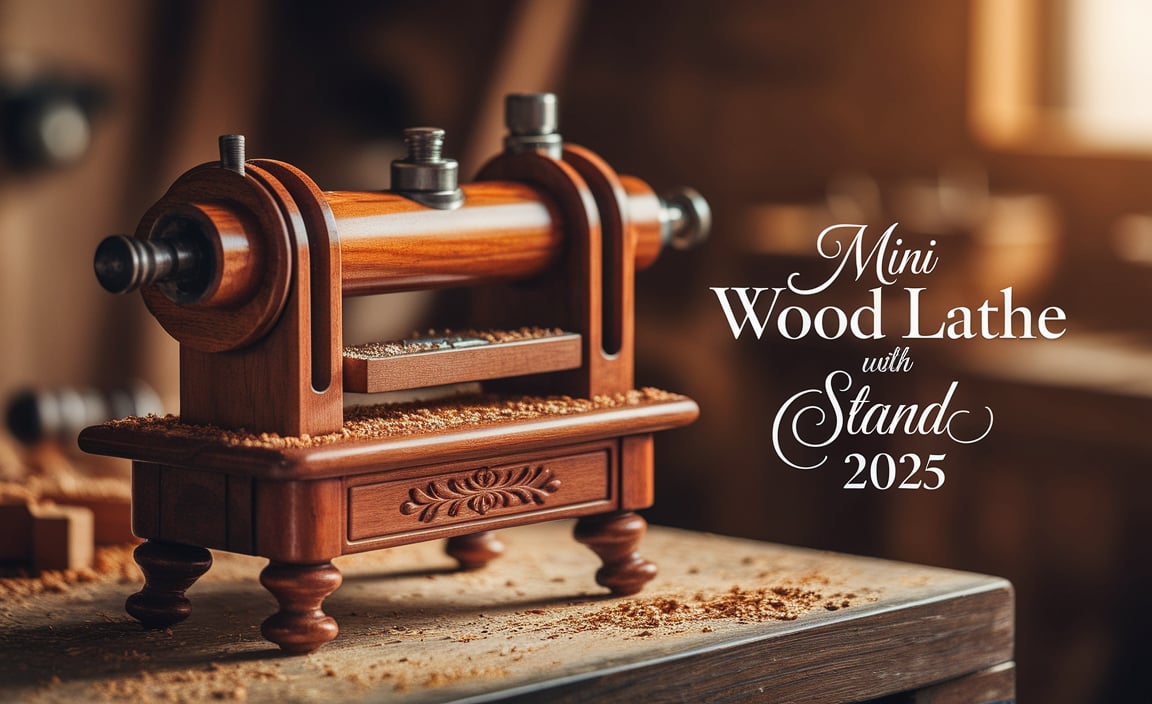A 1/8 inch carbide end mill is a go-to tool for cutting polycarbonate because its sharp edges and hardened material make clean, precise cuts without melting or cracking the plastic, unlike other bits.
Working with plastics like polycarbonate can be tricky. You might have a fantastic idea for a project, something that needs clear, strong material. But when you try to cut it, you get frustrating results: jagged edges, melted messes, or worse, cracked pieces. It’s a common problem, and it can make you doubt your abilities. Fortunately, the right tool makes all the difference. Today, we’re diving into why a specific kind of cutting bit—the 1/8 inch carbide end mill—is your best friend for tackling polycarbonate. We’ll break down exactly what makes it so good and how to use it effectively, so you can create those smooth, professional finishes you’re after.
Why Polycarbonate Needs Special Care
Polycarbonate is a marvel of modern materials. It’s incredibly strong, impact-resistant (ever heard of bulletproof glass? That’s often polycarbonate!), and optically clear. These properties make it perfect for a huge range of applications, from protective shielding and machine guards to DIY enclosures and custom lenses. However, these same properties also make it challenging to machine. Unlike wood or softer metals, polycarbonate has a relatively low melting point and can be prone to chipping and cracking if cut improperly. When you apply heat or excessive force with the wrong tooling, the plastic can begin to soften and gum up the cutting edges, leading to poor surface finish and potential workpiece damage.
Meet Your New Best Friend: The 1/8 Inch Carbide End Mill
So, what makes a 1/8 inch carbide end mill the star of the show for polycarbonate? It’s a combination of the material it’s made from and its specific design.
Carbide: The Hard Worker
Carbide, specifically tungsten carbide, is an extremely hard and durable man-made material. It’s formed by bonding tungsten carbide particles with a binder, typically cobalt. This creates a cutting tool that is:
- Significantly harder than high-speed steel (HSS). This hardness allows it to maintain a sharp cutting edge even at higher temperatures and during aggressive machining.
- More wear-resistant. It stands up to abrasion and friction much better than softer tool materials, meaning it stays sharp for longer, especially when cutting abrasive plastics.
- Capable of faster cutting speeds. Because it can handle more heat and wear, you can often use higher spindle speeds when machining with carbide, leading to quicker job completion.
For polycarbonate, this hardness translates to clean, sharp cuts that slice through the material without excessive heat buildup or deformation.
The 1/8 Inch Size: Precision and Control
The 1/8 inch diameter is crucial for several reasons when working with polycarbonate:
- Fine Detail: This small diameter allows for intricate cuts, sharp corners, and the creation of fine features that larger bits simply can’t achieve.
- Reduced Load: A smaller diameter puts less stress on both the cutting tool and your milling machine. This is vital for preventing tool breakage and for achieving a good finish on thinner polycarbonate sheets.
- Heat Management: A smaller flute volume means less material is being removed at any given moment, which helps in managing the heat generated during the cut. Less heat means less melting and cleaner edges.
Stub Length: Stability for Thin Materials
When you see “stub length” mentioned with a 1/8 inch end mill, it generally means the length of the cutting flutes (the spiral grooves) is shorter than a standard end mill of the same diameter. For polycarbonate, especially thinner sheets, a stub length offers:
- Increased Rigidity: Shorter tools are inherently stiffer, meaning they deflect less under cutting forces. This leads to more accurate cuts and reduces the chance of the bit wobbling, which can cause a rough finish or breakage.
- Easier Setup: A stub-length end mill has less overhang from the collet or tool holder, providing a more stable tool path.
1/4 Shank: The Standard Connection
The 1/4 inch shank is a very common size for end mills, especially in smaller diameters. This means it will fit into a vast majority of milling machine collet systems and tool holders designed for desktop CNC machines and smaller industrial mills. Ensuring compatibility with your existing tooling is always a practical consideration!
Why Not Use a Standard End Mill?
You might wonder why a specialized carbide end mill is necessary when you have other bits lying around. Here’s a quick breakdown:
- High-Speed Steel (HSS) End Mills: While great for many materials, HSS tends to generate more heat when cutting plastics like polycarbonate. This increased heat can cause the plastic to melt and stick to the cutting edges, leading to a gummy finish and potentially chip formation on your workpiece.
- Standard Two-Flute Bits (Even Carbide): A standard two-flute end mill is often designed for chip evacuation in metal. While often a good starting point, for plastics, specialized plastic-cutting end mills (which often have fewer flutes and a different helix angle) can perform even better by reducing friction and pulling chips away more efficiently. However, a general-purpose 2-flute carbide end mill can still work well for polycarbonate if used correctly.
- Drill Bits: Drill bits are designed for making holes. Using them to cut shapes or slots can result in a rough, imprecise path and significantly more heat generation. They don’t have the side-cutting capability of an end mill.
Key Features to Look for
When selecting your 1/8 inch carbide end mill for polycarbonate, keep these specific features in mind:
- Number of Flutes: For plastics, 1- or 2-flute end mills are generally preferred. Fewer flutes mean larger chip pockets, allowing for better chip evacuation and reducing re-cutting of chips, which generates heat. More flutes can sometimes lead to excessive heat buildup in plastics.
- Helix Angle: A high helix angle (often 45° or more) is beneficial for plastics. This steep angle helps pull chips out of the cut more effectively and can improve surface finish.
- Coating: While not strictly necessary for polycarbonate, some coatings can further enhance performance by reducing friction and heat. However, a good quality uncoated carbide end mill will still perform admirably.
- Material: Ensure it’s solid carbide. Avoid end mills that have carbide tips brazed onto a steel body for high-speed plastic cutting, as the brazing point can be a weakness.
Setting Up for Success: The Right Machining Parameters
Having the right tool is only half the battle. Proper machining parameters—speed, feed rate, and depth of cut—are critical for cutting polycarbonate cleanly and efficiently with your 1/8 inch carbide end mill.
Spindle Speed (RPM)
Spindle speed refers to how fast the cutting tool rotates. For polycarbonate, you generally want to run at moderate to high speeds. This helps the bit cut cleanly rather than scrape and melt. A good starting point for a 1/8 inch carbide end mill in polycarbonate might be:
- 20,000 – 30,000 RPM
Higher speeds help create a shearing action, which is ideal for plastics. Always listen to your machine and material. If you hear squealing or see melting, the speed might be too low, or your feed rate too high.
Feed Rate (IPM or mm/min)
Feed rate is how fast the milling machine moves the cutting tool through the material. It needs to be balanced with the spindle speed. A feed rate that is too slow can cause excessive heat buildup and melting, while a feed rate that is too fast can overload the tool or cause chipping. For a 1/8 inch carbide end mill in polycarbonate, you’ll want a relatively fast feed rate to ensure the tool is actually cutting material rather than rubbing.
- 15 – 30 Inches Per Minute (IPM) or 380 – 760 mm/min
A good rule of thumb is to aim for a chip load (the thickness of material removed by each cutting edge) of around 0.001 to 0.003 inches per flute. You can calculate this by: Chip Load = Feed Rate / (Number of Flutes * Spindle Speed).
Depth of Cut (DOC)
The depth of cut is how deep the end mill plunges into the material with each pass. For polycarbonate, it’s crucial to use conservative depths of cut, especially for the first few passes. This minimizes the load on the tool and reduces heat generation.
- Roughing Pass: 0.06 to 0.125 inches (1.5 mm to 3 mm)
- Finishing Pass: 0.01 to 0.02 inches (0.25 mm to 0.5 mm)
Making a shallow finishing pass at the end is key to getting a really clean edge. This pass removes minimal material, acting more like a polish and cleaning up any minor imperfections from the roughing passes.
Feeds and Speeds Chart Example
The following is a general guideline. Always perform test cuts on scrap material first to optimize your settings.
| Material | Tool Diameter | Tool Type | Spindle Speed (RPM) | Feed Rate (IPM) | Depth of Cut (Inches) | Chip Load per Flute (Inches) |
|---|---|---|---|---|---|---|
| Polycarbonate | 1/8″ Carbide End Mill (2-flute) | General purpose or high-helix plastic cutter | 20,000 – 25,000 | 15 – 25 | 0.06 – 0.125 (roughing) 0.01 – 0.02 (finishing) |
0.001 – 0.002 |
Note: These values are starting points. Factors like the rigidity of your machine, the quality of the end mill, and the thickness of the polycarbonate can influence optimal settings.
Cooling and Lubrication: Keep it Chill
While polycarbonate doesn’t require flood coolant like aluminum, managing heat is still paramount. Excessive heat is your enemy; it leads to melting and poor cut quality. Here are some methods:
- Air Blast: A directed stream of compressed air aimed at the cutting area is often sufficient. It blows chips away and helps dissipate heat. Many CNC machines have built-in air blast nozzles.
- Mist Coolant: A fine mist of coolant can be very effective. It lubricates the cut and provides excellent cooling without the mess of flood coolant.
- Cutting Fluid/Lubricant (Use Sparingly): For plastics, a specific plastic-cutting fluid can help reduce friction and heat. Apply it sparingly directly to the cutting zone. Be aware that some lubricants can cause clouding or crazing in certain plastics, so test first. Avoid heavy oils that can gum up the flutes.
For smaller projects or less powerful machines, simply pausing periodically to let the tool and material cool down can also be effective.
Step-by-Step: Cutting Polycarbonate with Your End Mill
Let’s walk through the process. Imagine you’re cutting out a specific shape from a sheet of polycarbonate.
- Secure Your Workpiece: Ensure the polycarbonate sheet is firmly clamped to your milling machine’s table. Use a backing board (like MDF or scrap plywood) underneath the polycarbonate to prevent tear-out on the bottom edge and to protect your machine table.
- Install the End Mill: Insert your 1/8 inch carbide end mill into the collet and secure it in the spindle. Make sure it’s seated properly and tightened firmly.
- Set Your Zero Point: Use your CNC’s probing system or manual methods to accurately set the X, Y, and Z zero positions for your program. This is critical for precise cuts.
- Program Your Toolpath: Design your cut in CAD/CAM software and generate the G-code. Ensure you’ve set the correct tool diameter (1/8 inch) and are using appropriate speeds and feeds (refer to our chart as a starting point).
- Perform a Dry Run: Before cutting the actual material, run your CNC program with the spindle OFF. Watch the toolpath to ensure it’s correct and that the tool isn’t going to collide with anything.
- Start the First Cut: Turn on your cooling method (air blast, mist). Start the spindle to your target RPM. Then, engage the feed rate to begin the first cutting pass at your programmed depth of cut.
- Monitor the Cut: Listen carefully to the sound of the cut. A smooth, consistent chipping sound is good. High-pitched squealing or a grinding noise means something is wrong (likely feed rate too slow, or depth of cut too high, causing melting). Watch for excessive chip buildup or visible melting.
- Take Multiple Passes: For deeper cuts, let the machine complete the first pass. Retract the tool, and have it peck deeper for the next pass. Always aim to leave a small amount of material for a final finishing pass.
- Make the Finishing Pass: Once all roughing passes are complete, run the toolpath again with a very shallow depth of cut (0.001-0.02 inches). This pass is where you achieve that glass-smooth edge. Use a slightly higher feed rate for this pass if your machine allows, as it helps achieve a polished look.
- Inspect the Results: Once the cut is complete, carefully remove the workpiece. Inspect the edges for smoothness, clarity, and absence of melting or chipping.
Troubleshooting Common Issues
Even with the right tool, you might encounter a few snags. Here’s how to fix them:
- Melting/Gummy Edges:
- Cause: Too much heat, feed rate too slow, depth of cut too deep, or dull tool.
- Solution: Increase feed rate, decrease depth of cut, improve cooling (more air blast, mist coolant), or use a sharper tool. Ensure your spindle speed isn’t too low.
- Chipping/Cracking:
- Cause: Feed rate too fast, depth of cut too aggressive, brittle material grade, or insufficient support.
- Solution: Decrease feed rate, shallow depth of cut, ensure material is well-supported with a backing board. Check if you’re using a high-impact polycarbonate grade.
- Poor Surface Finish (Rough Edges):
- Cause: Tool wobble, dull tool, incorrect feed/speed, or not enough engagement with the material.
- Solution: Ensure the end mill is properly secured and isn’t vibrating. Use a fresh, sharp end mill. Make a dedicated finishing pass at a shallow depth. Ensure adequate chip load.
- Tool Breakage:
- Cause: Excessive feed rate, depth of cut too aggressive, improper clamping of workpiece, leading to tool chatter.
- Solution: Reduce feed rate and depth of cut. Ensure the workpiece is rock-solid. Make sure there’s no tool runout.
Where to Find Quality 1/4 Shank Carbide End Mills
You can find 1/8 inch carbide end mills from a variety of reputable suppliers. Look for those specializing in CNC tooling, machining supplies, or even reputable online marketplaces. When purchasing, pay attention to the specifications:
- American Carbide Tools: Many users find American-made or European-made carbide tools offer superior quality and consistency.
- Online Retailers: Sites like Amazon, eBay, and dedicated industrial supply stores often carry a wide selection. Read reviews carefully!
- Specialty CNC Shops: Companies like Precise Bits, Bits & Bits, or Carbide Pro specializing in router and CNC bits often have excellent options tailored for plastics.
- Industrial Supply Houses: Grainger, McMaster-Carr, and MSC Industrial Supply are excellent sources but can be more expensive.
For polycarbonate, look for end mills listed as “plastic cutting,” “acrylic cutting,” or “non-ferrous metal/plastic” end mills. These are often optimized with high helix angles and polished flutes.
Beyond Polycarbonate: Other Plastics
While this guide focuses on polycarbonate, the principles discussed—using carbide, managing heat, and employing proper speeds and feeds—apply to machining many other plastics as well. This includes materials like:
- Acrylic (PMMA): Similar to polycarbonate but can be more brittle. A sharp carbide end mill with good cooling is essential.
- Delrin (Acetal): A slick, self-lubricating plastic that machines very well. Carbide end mills are ideal.





